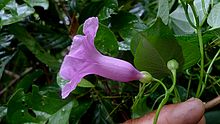| Ipomoea batatoides | |
|---|---|

| |
| Scientific classification | |
| Kingdom: | Plantae |
| Clade: | Tracheophytes |
| Clade: | Angiosperms |
| Clade: | Eudicots |
| Clade: | Asterids |
| Order: | Solanales |
| Family: | Convolvulaceae |
| Genus: | Ipomoea |
| Species: | I. batatoides
|
| Binomial name | |
| Ipomoea batatoides | |
| Synonyms[1] | |
| |
Ipomoea batatoides is a species of flowering plant in the family Convolvulaceae.[2]
This species is found in sub-deciduous tropical forest, from about 100 to 200 meters above sea level. It blooms from August to November.[3]
The species is native to Belize, Bolivia, Brazil, Colombia, Costa Rica, Ecuador, El Salvador, French Guiana, Guatemala, Guyana, Honduras, Mexico, Nicaragua, Panamá, Peru, Suriname, and Venezuela.[4]
References
[edit]- ^ "Ipomoea batatoides". Global Biodiversity Information Facility. Retrieved 30 September 2021.
- ^ "Ipomoea batatoides" at the Encyclopedia of Life
- ^ Carranza, E. (2007). "Familia Convolvulaceae". Flora del Bajío y de Regiones Adyacentes. Fascículo 151.
- ^ "Ipomoea batatoides". Plants of the World Online. Royal Botanic Gardens, Kew. Retrieved 30 September 2021.
Well, that’s interesting to know that Psilotum nudum are known as whisk ferns. Psilotum nudum is the commoner species of the two. While the P. flaccidum is a rare species and is found in the tropical islands. Both the species are usually epiphytic in habit and grow upon tree ferns. These species may also be terrestrial and grow in humus or in the crevices of the rocks.
View the detailed Guide of Psilotum nudum: Detailed Study Of Psilotum Nudum (Whisk Fern), Classification, Anatomy, Reproduction